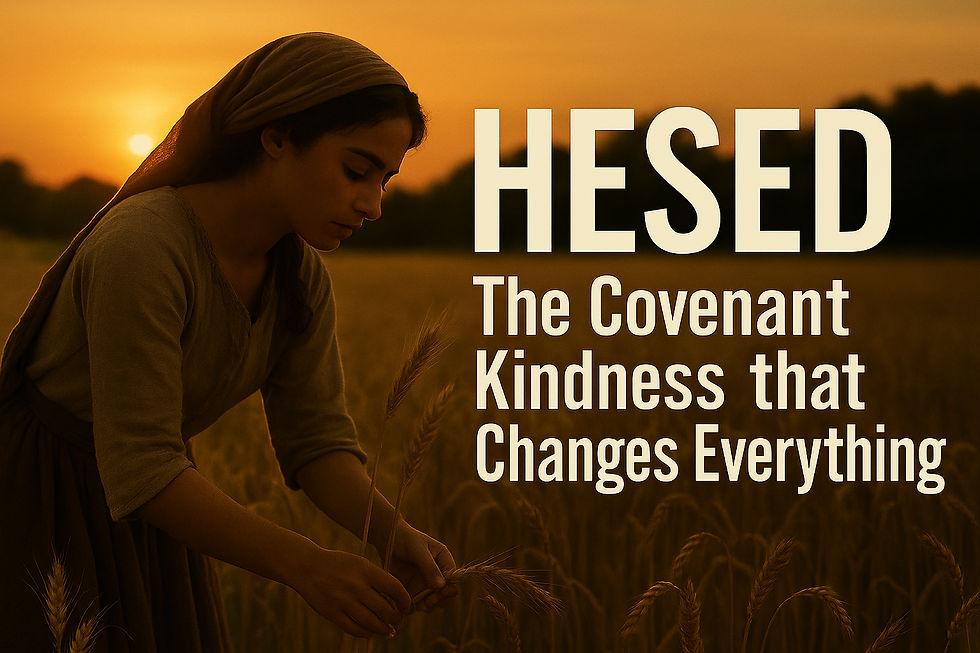Ḥesed: The Covenant Kindness That Changes Everything
- Bible Believing Christian

- Oct 21
- 4 min read

Ḥesed: The Covenant Kindness That Changes Everything
If the Book of Ruth has a heartbeat, it is ḥesed (חֶסֶד). This Hebrew word—translated as “lovingkindness,” “steadfast love,” or “mercy”—is far more than emotion. It is the covenant DNA of God’s character, the glue of grace that holds every act of redemption from Genesis to Revelation.
In Ruth, ḥesed is not only spoken—it is embodied. Ruth shows ḥesed toward Naomi, Boaz shows ḥesed toward Ruth, and God shows ḥesed toward them both. What unfolds in these four short chapters is a living theology of divine faithfulness that turns famine into fullness and bitterness into blessing.
Biblical Foundation
“May the Lord deal kindly with you, as you have dealt with the dead and with me.” (Ruth 1:8, NASB)
“Blessed be the Lord, who has not withdrawn His kindness to the living and to the dead.” (Ruth 2:20, NASB)
“May you be blessed of the Lord, my daughter. You have shown your last kindness to be better than the first by not going after young men, whether poor or rich.” (Ruth 3:10, NASB)
Each of these verses turns on the word ḥesed. It is the thread that ties the narrative together, transforming ordinary acts of compassion into eternal covenant witness.
Word Study — What Ḥesed Means
The Hebrew ḥesed (חֶסֶד) defies simple translation. It combines the ideas of loyalty, mercy, faithfulness, and covenant obligation. Scholars have called it “the most significant word in the Hebrew Bible,” because it captures the very nature of God’s dealings with His people.
Unlike ahavah (אָהָבָה, “love”), which can express affection or emotion, ḥesed is love bound by covenant—faithful, active, and enduring. It’s what keeps God’s promises intact even when His people falter.
In the Septuagint, ḥesed is rendered ἔλεος (eleos)—“mercy.” The word resurfaces throughout the New Testament, forming the foundation for God’s redemptive compassion in Christ. When Luke writes, “His mercy (ἔλεος) is upon generation after generation toward those who fear Him” (Luke 1:50, NASB), he’s echoing the ḥesed of Ruth’s story.
John picks up the same thread in his Gospel:
“The Word became flesh and dwelt among us, and we saw His glory, glory as of the only Son from the Father, full of grace and truth.” (John 1:14, NASB)
In Greek, “grace and truth” (charis kai alētheia) deliberately echoes ḥesed we’emet (חֶסֶד וֶאֱמֶת, “steadfast love and faithfulness”) from Exodus 34:6.In short: Jesus is the living embodiment of ḥesed.
Historical Context
In the ancient Near East, ḥesed was countercultural. Pagan gods were fickle and transactional; loyalty lasted only as long as it was profitable. But Israel’s God was different—faithful even when His people were faithless.
The Book of Ruth unfolds during the era of the Judges—summed up by the refrain:
“Everyone did what was right in his own eyes.” Against that backdrop of chaos, Ruth’s ḥesed is radical.
As a Moabite widow, she owed Naomi nothing. Yet she pledges, “Where you go, I will go… your people shall be my people, and your God, my God.” (Ruth 1:16, NASB)
This is covenant language from a woman outside the covenant—a foreigner mirroring the faithfulness of God Himself.
Boaz responds in kind. His ḥesed is more than obligation—it’s compassion expressed through righteous action. He blesses Ruth:
“May the Lord reward your work, and may your wages be full from the Lord, the God of Israel, under whose wings you have come to seek refuge.” (Ruth 2:12, NASB)
Through these intertwined acts of kindness, divine providence quietly reclaims the story.
Misconceptions & Clarifications
“Ḥesed just means kindness or sympathy.”
Not so. Ḥesed isn’t a feeling—it’s covenant loyalty in action. It requires sacrifice. Ruth’s ḥesed meant leaving her home and security; Boaz’s ḥesed meant risking wealth and reputation to redeem her.
“Ḥesed describes only God’s love, not human behavior.”
Ruth proves otherwise. Human ḥesed mirrors divine ḥesed. God’s covenant love flows through His people, not just to them.
“Ḥesed is limited to Israel.”
Ruth, a Moabite, shatters that assumption. Her faith and loyalty prefigure the inclusion of Gentiles into God’s covenant family.
Theological Reflection
Ḥesed bridges law and love. The law says, “You must.” Ḥesed says, “I will.”It fulfills the law’s intent while surpassing its letter.
Theologically, ḥesed reveals how God operates even when His hand seems hidden. What looks like coincidence—Ruth gleaning in Boaz’s field—becomes providence guided by ḥesed.
In Scripture’s unfolding revelation, there’s a divine linguistic progression:
Each stage unveils the same divine reality: God’s unwavering kindness made visible in Christ.
Connection to Christ
Boaz prefigures Christ not only as go’el (גֹּאֵל, “kinsman-redeemer”), but as the living channel of ḥesed. He redeems Ruth not out of duty but devotion—just as Christ redeems humanity through love, not law.
Boaz covers Ruth with his cloak; Christ covers His Church with His righteousness. Ruth finds refuge under Boaz’s wings; believers find eternal refuge under Christ’s.
The Cross becomes the ultimate expression of ḥesed: divine love keeping divine promise, even at infinite cost.
Christ-Centered Conclusion
Ruth’s story is a small window into the vast heart of God. Her loyalty, Boaz’s faithfulness, and God’s hidden hand together reveal a love that never quits—a ḥesed that renews every morning.
In a culture where love is conditional and loyalty is fleeting, ḥesed still calls us higher:
to love without gain,
to serve without return,
and to remain faithful when no one’s watching.
“The Lord’s lovingkindnesses indeed never cease, for His compassions never fail. They are new every morning; great is Your faithfulness.”— Lamentations 3:22–23, NASB
Scripture quotations taken from the New American Standard Bible® (NASB)Copyright © 1960, 1971, 1977, 1995, and 2020 by The Lockman Foundation. Used by permission. All rights reserved.


